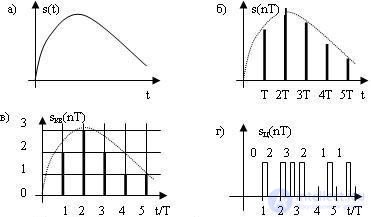Lecture
Various signs can be used to classify the signals used in communication: according to the method of describing the signal model, according to the degree of predictability of this signal, etc.
According to the method of describing a mathematical model, the signals are divided into continuous and discrete. Signals specified on a continuous set of points along the time axis are called continuous, and signals specified not on the entire time axis, but only at individual points, are called discrete (intermittent) in time. Signals defined on a continuous set of points in a level are called analog signals, and signals that in a level can take values only in certain points of it are called level quantized.
Signals can be discrete simultaneously in both time and level. Each discrete value of such a signal can be numbered with numbers with a finite number of digits. Signals whose behavior can be described by a sequence of numbers, called digital.
Figure 3.4 shows some types of signals. The signal s (t), continuous in time and level, is shown in Figure 3.4, a. The samples (also say sampled values, or just samples) of this signal s (nT) at time t = nT, where n is any integer, T is the sampling period; represent a sampled signal and are shown in Figure 3.4, b. The rounded values of these counts Sqv (nT) are shown in Figure 3.4, c. Rounding can be done in various ways. For the rounding result, you can take the value corresponding to either the beginning, or the end, or the middle of the interval in which the signal value falls. But any quantization algorithm involves determining the interval in which the value of the quantized signal falls.
For the signal shown in these figures, it can be seen that the count with the number n = 0 falls within the range of the signal levels with the number 0; the count with the number n = 1 falls into the interval with the number 2. The subsequent samples of the signal with the numbers 2, 3, 4, 5 fall into the intervals of the levels with the numbers 3, 2, 1, 1, respectively.

Fig. 3.4 Types of signals: a) continuous analog;
b) discrete in time, continuous level;
c) discrete in time quantized by level;
d) digital signal
The numbers of these intervals are encoded, for example, by a binary code. Then the decimal digits 0, 1, 2, 3 in binary form will be represented by a set of numbers, respectively, 00, 01, 10, 11. If binary digit 1 is represented by the presence of a pulse at a certain time interval, and binary digit 0 is the absence of a pulse, then the sequence pulses, carrying information about the rounded value of the samples, and will be a digital signal sц (nT).
By the degree of predictability, the signals differ in deterministic and random. A deterministic signal is a signal that is completely predictable, that is, all the parameters of which are known in advance and reliably. A random signal is a signal in which at least one of the parameters cannot be predicted in advance exactly. From an informational point of view, a deterministic signal corresponds to a previously known message and therefore does not carry new information. A message carrier containing information can only be a random signal. At the same time, deterministic signals in communication systems play a no less prominent role: they display reference signals that carry collisions, fragments of signals generated at the transmitting end, and so on. And when analyzing the functioning of receiving equipment of communication systems, it is often assumed that a signal of a known shape is received, but with unknown parameters.
The main signal parameters in communication systems use the signal duration, its dynamic range and the width of the spectrum. Under the duration of the signal Tc <understand the time interval within which the signal exists. The dynamic range of a DC signal is determined by the ratio of the highest instantaneous signal power to the lowest received signal power for a given transmission quality (usually expressed in decibels). The width of the spectrum of the FC signal determines the frequency range in which the bulk of the signal energy is concentrated, which gives an idea of the rate of change of the signal within its interval of existence. The signals of finite duration contain spectral components in an unlimited frequency band. However, for any signal, you can specify the frequency range within which its main energy is concentrated. This range determines the width of the signal spectrum. Integral characteristics are also used: the signal base Bc = TcFc and the signal volume Vc = TcFcDc.
The volume of the VC signal gives a general idea of the capabilities of this set of signals as message carriers. The larger the signal volume, the more information can be “invested” in this volume and the more difficult it is to transmit such a signal via the communication channel.
Comments
To leave a comment
Devices for the reception and processing of radio signals, Transmission, reception and processing of signals
Terms: Devices for the reception and processing of radio signals, Transmission, reception and processing of signals